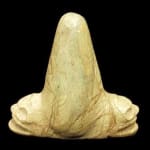Taino Stone Trigonolitos, 1100 CE - 1500 CE
Stone
7.25 x 7
AM.0080
The Taino flourished in the Caribbean between c.1200-1500. They were the first Americans to make contact with the Spanish in 1492 and to suffer as a result. Many of the...
The Taino flourished in the Caribbean between c.1200-1500. They were the first Americans to make contact with the Spanish in 1492 and to suffer as a result. Many of the features today associated with the Taino, such as ball-courts and three-pointers, were first used by their predecessors who migrated to the islands from both South America and Mesoamerica. However as society became more organised under the Taino, the political system increased in complexity and agricultural production intensified, artistic creativity also flourished. Earlier three-pointers were often undecorated and small in size. During the Taino heyday they became increasingly important to public ritual and therefore larger and more intricate. The central cone of these triangular objects has been interpreted in a variety of ways. Suggestions include manioc shoots (one of the main crops of the Taino), volcanoes, the roofs of Taino houses, phalluses and the human breast. None of these theories has been universally accepted and the precise origins of the shape are likely to remain a mystery. Despite this many scholars agree that these ceremonial objects were symbols of power and fertility. This seems to be supported by a letter written by Columbus in which he reports on his findings among the Taino, ‘Equally the majority of caciques (chiefs) have three stones to which they and their people have great devotion. One they say is for the fertility of the grain and vegetables that they grow; the next for mothers to give birth without pain, and the third for the water and sun when they have need.’
Taino stone carvings were worked with two types of tool: bone and flint chisels and a taut chord that cut through the stone with the aid of water and fine sand. The creator of this three-pointer obviously delighted in the natural veining of the raw material. It adds to the texture of the surface just as effectively as incised decoration would have done. The face of an animal adorns both ends of the triangle. Although it is impossible to identify with certainty it clearly had a spiritual significance for its original owner.
Taino stone carvings were worked with two types of tool: bone and flint chisels and a taut chord that cut through the stone with the aid of water and fine sand. The creator of this three-pointer obviously delighted in the natural veining of the raw material. It adds to the texture of the surface just as effectively as incised decoration would have done. The face of an animal adorns both ends of the triangle. Although it is impossible to identify with certainty it clearly had a spiritual significance for its original owner.



